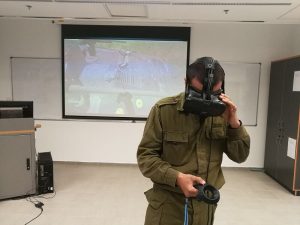This post is also available in:
 עברית (Hebrew)
עברית (Hebrew)
Virtual Reality (VR) technology has considerably improved the training and instruction of professional teams in various fields, from maintenance at the aviation industry to surgery and healthcare. In recent years, this technology has been used in various military applications. The IDF recently started to operate an innovative VR simulator at the instruction course for the Namer Armored Personnel Carrier, technologically the newest among IDF’s ground vehicles.
The instruction course which takes place at Training Base no. 20, the technology and instruction base at the IDF City of Training Bases, incorporates advanced VR simulation. The course includes the maintenance professions in the electricity, electronics and mechanics, and the majority of the participants are technological academic reserve (Atuda) soldiers.

In a special interview to iHLS, the commander of the Namer course, Command Sergeant Major Baruch Gal, says the development of the new simulator operative already for eight months was executed within the IDF, by the Technology and Maintenance Corps in cooperation with the Tank Development Authority, the developer of the Merkava tank and the Namer, with the knowledge and instruction of Training Base 20.
The VR simulator was designed for training and instruction of soldiers, basing on the understanding of the needs of the “Y generation,” which is connected to technologies and screens rather than to instruction books. The system enables to present an almost realistic view of the Namer – its various parts, structure, and configurations. The instruction on the simulator is the last stage before the practical training, and of course does not replace it, says Command Serg. Maj. Gal.
Indeed, the simulator provides the soldiers with a completely immersive experience. The simulator is built inside a classroom, and the soldiers are equipped with VR glasses connected to a computer. The system includes sensors that sense the location of the trainee in relation to the environment and a remote control device.
The simulator can show parts of the vehicle that are hidden inside the APC. In addition, it allows changing the virtual environment from the ground level to the vehicle height level. The soldiers experience a dynamic instruction instead of a static one. They can see the virtual Namer almost on real size and can move around it, inside, or even virtually “stand on” the vehicle and look down, as the immersive experience makes them “jump over” virtual openings in the vehicle’s upper part.
Complementing the sensation aspect, a virtual board incorporated in the system includes the instructional material, so that the trainee can watch while he/she “wonders around” the vehicle a detailed explanation, just by pointing with the control device at the part that interests him. The information on the screen includes animation and video clips that describe the dismantling and construction of the vehicle’s different parts so that at the end of the day, the soldier experiences the APC and the environment with layers of vocal, visual and textual information.
Command Serg. Maj. Gal concludes that undoubtedly, the experience of training with the new simulation technology enhances the soldiers’ motivation to learn and improves the level of understanding and expertise.


























